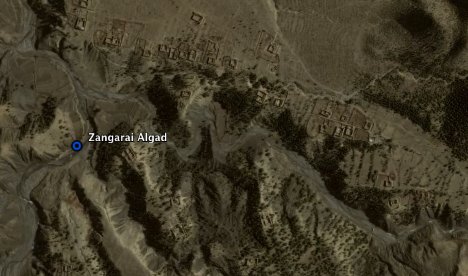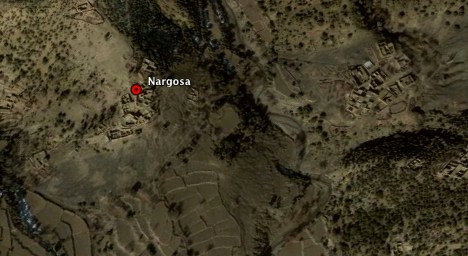Regarding the probable killing of Taliban leader Baitullah Mehsud: The BBC reports that:
The missile fired by the US drone hit the home of the Taliban chief’s father-in-law, Malik Ikramuddin, in the Zangarha area, 15km (9 miles) north-east of Ladha, at around 0100 on Wednesday (1900 GMT Tuesday).
Ladha was easily found via a default search in Google Earth (and the returned placemark comes courtesy of an entry in Google Earth Community); it is indeed in the South Waziristan region of Pakistan, and is the location of an old British fort. Then it was a matter of finding Zanghara. Here Geonames.org once again proved to be an invaluable resource. A fuzzy search for “Zangarha” in Pakistan returned one clear answer exactly 15km northeast of Ladha: Zangarai Algad, where “algad” denotes that the feature name is a stream or shallow valley. This valley extends northeast-southwest for a few kilometers, and I think it is likely this is the place referred to by the article.

The location can further be confirmed by looking up the purported burial place of Baitullah Mehsud. Reuters reports:
“He was killed with his wife and he was buried in Nargosey,” the [Pakistani] officer said, referring to a tiny settlement about 1 km (half a mile), from the site of the attack, believed to have been carried out by a pilotless U.S. drone aircraft.
(Dawn and the BBC refer to the village as “Nardusai”, but such discrepancies are frequent when transposing names to English.)
Browsing with Geonames.org in the immediate vicinity of the Zangarai placemark, it only took seconds to chance upon “Nargosa” village, one of the very few inhabited places in the remote and hilly area. Such successful triangulation of place names makes it quite likely in my mind that this is the place referred to.

Serendipitously, this spot has high-resolution DigitalGlobe imagery, taken on January 7, 2007. Individual houses and fortified compounds in the valleys and villages are clearly visible, and invite perusal. Barring any help from the US or Pakistani military or GPS-equipped journalists escorted into the area, it is unlikely we’ll get a more precise pointer to the targeted location.
Here is the file with all the relevant POIs referred to in this post. If you use them with the Geonames auto-refreshing network link linked to above, you can browse the area amid a wealth of obscure place names called up from Geonames’ database on the fly. If you want to know what kind of terrain the Taliban have as their home turf, take a look.
excellent research! thnx stefan;)
You may soon pioneer a new stream of journalism based solely on Google Earth. Great work, Stefan! Awaiting your next hit…